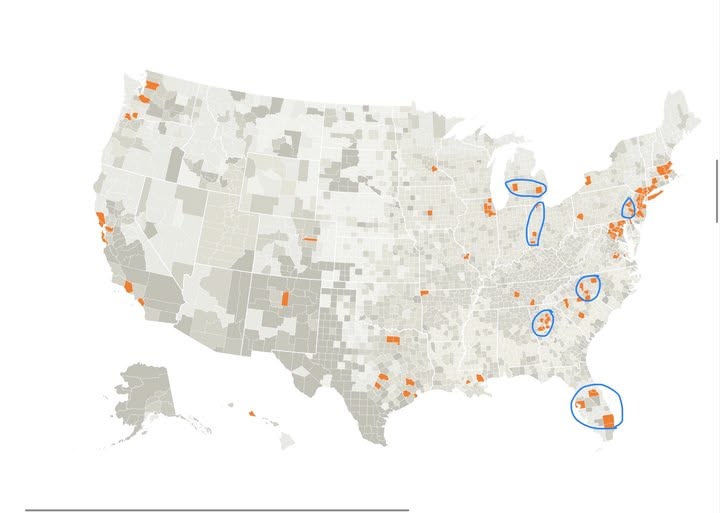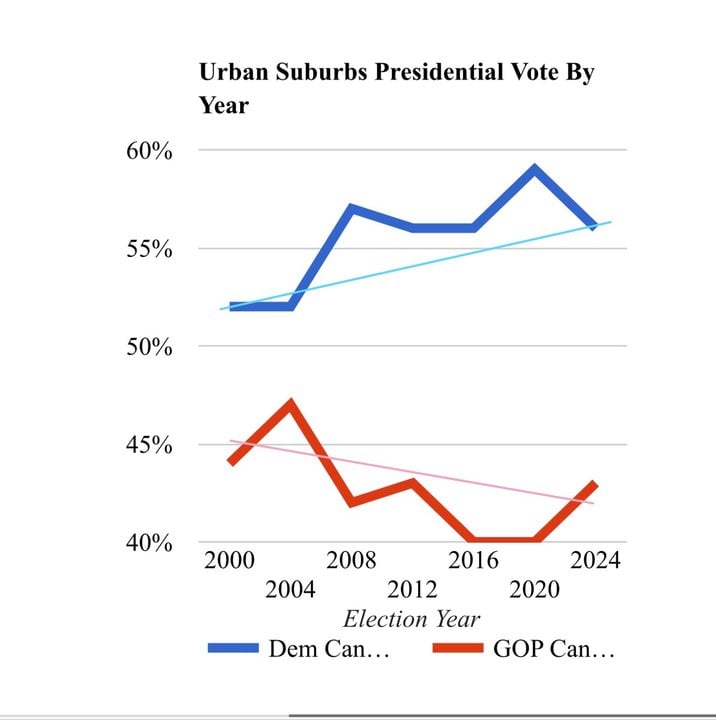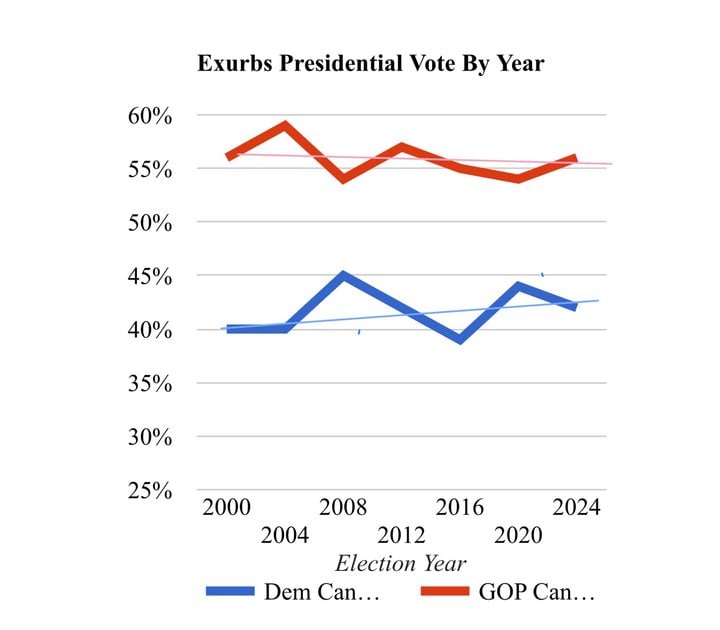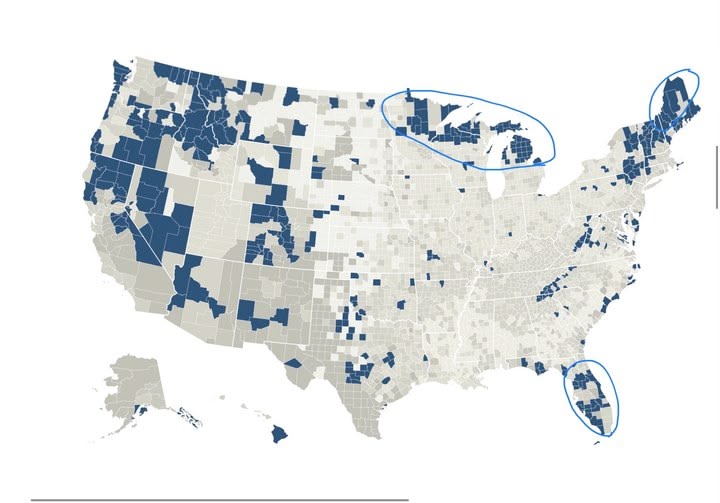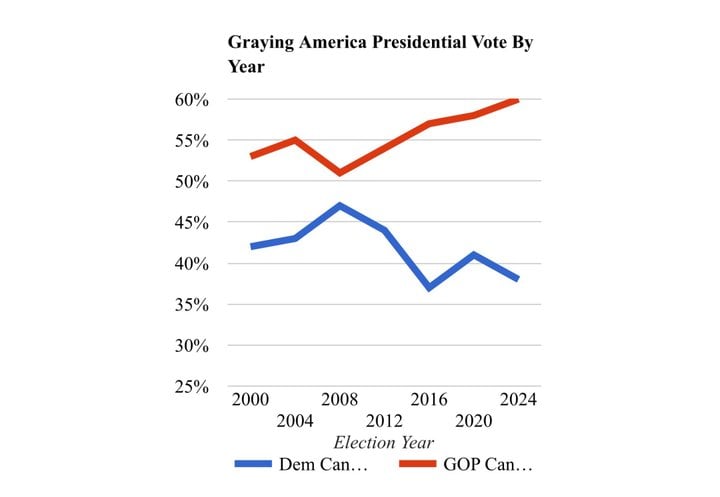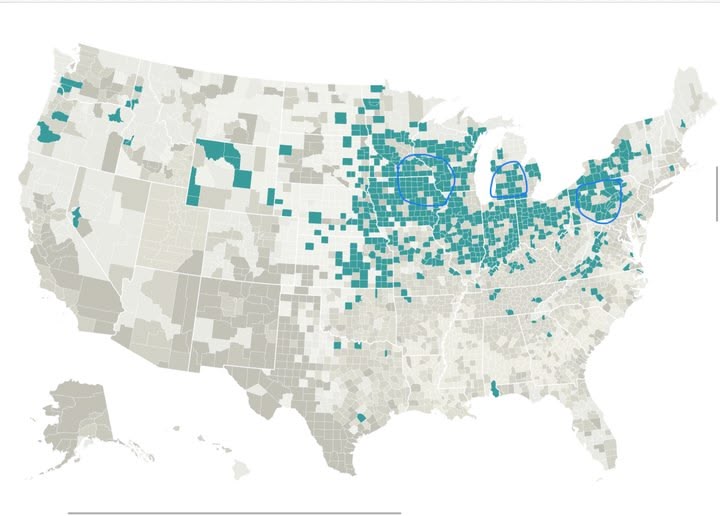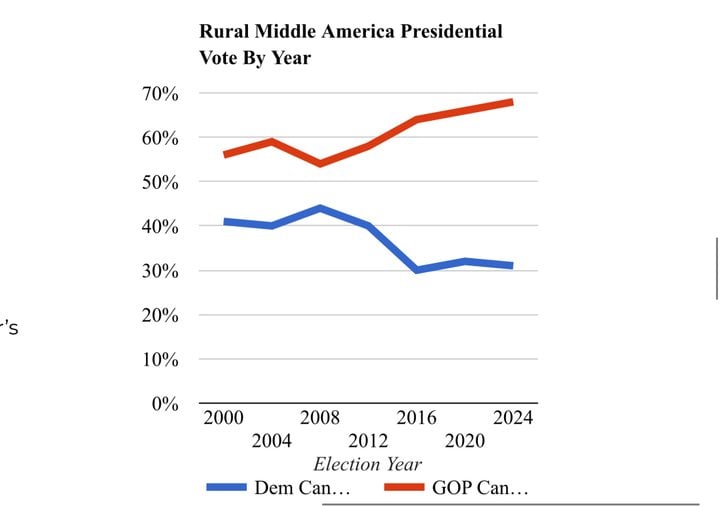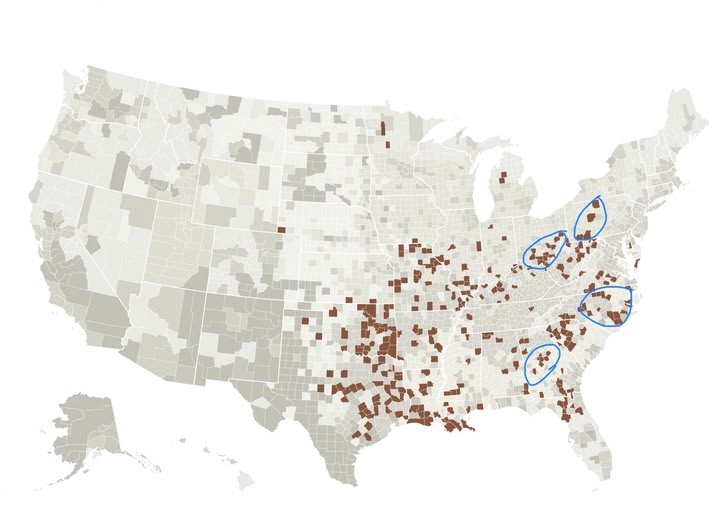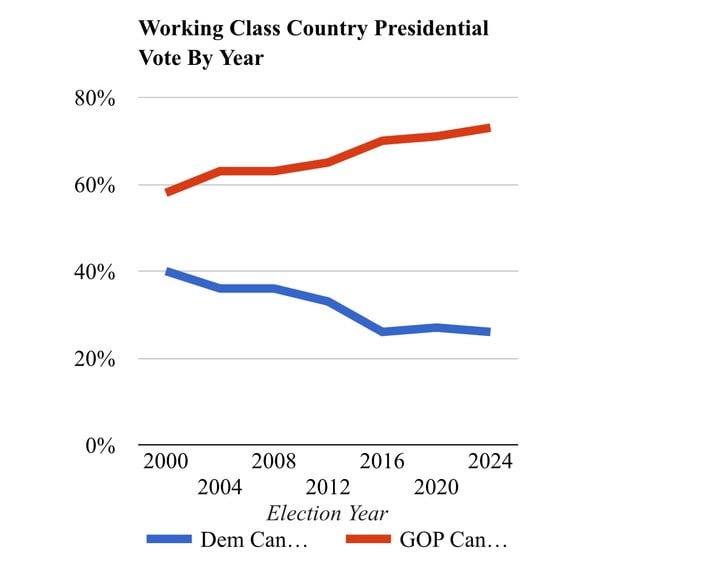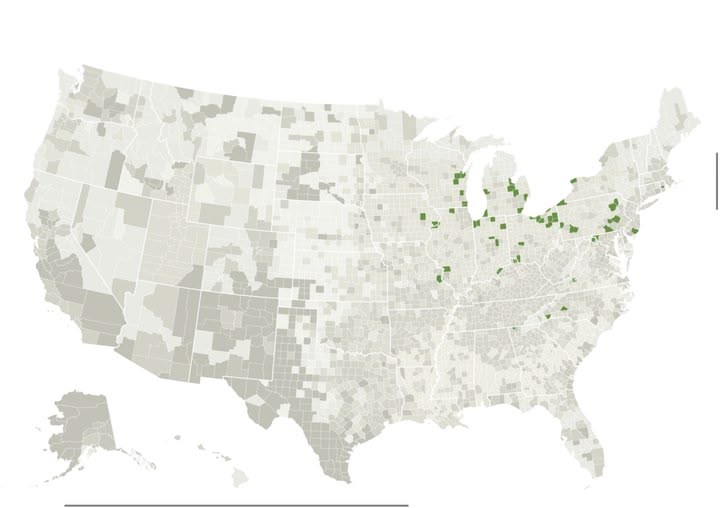Trump didn‘t cause the structural problems of the Democratic Party
There‘s this idea that Trump, by abandoning social conservatism, neoliberalism and neoconservatism won the 2016 and 2024 election.
For progressives that explanation is ideal because it would mean Democrats have to shed whatever residual neoliberalism or foreign policy activism is left in them to win.
It‘s a simplistic and transparent narrative, but more importantly, it’s false.
Let‘s dig into the county-level statistics and consider the key geo-demographic groups, swing voters in swing states, because those are the voters who actually decide elections. Not AOC voters in the Bronx, Sanders voters in Vermont or Ro Khanna voters in the Bay Area.
Let‘s start with the relevant counties where the Democrats have made structural gains since 2000.
First, let’s examine urban suburban areas.
Those counties are defined as follows:
Democrats generally won over or increased their margins in most urban suburbs since 2000. Those margins are highly consequential in Georgia, NC and Pennsylvania where suburban Atlanta, Charlotte and Philadelphia are indispensable for any plausible Democratic path to victory.
The only other relevant geo-demographic county type where the Democrats made structural inroads are exurbs.
Here‘s a definition:
Those are still predominantly Republican areas but the Democrats have slightly improved while the Republicans have given some ground. As with the urban suburbs, the effect of any shift in these areas is most electorally significant in PA, GA and NC.
Let‘s move on to the relevant county types that became increasingly hostile territory for Democrats.
For one, there’s graying America which can be defined as follows:
The growing structural advantage of Republicans in these counties is particularly critical in Florida, and northern Wisconsin and Michigan. It might plausibly affect the future of Maine and Minnesota as safely Democratic states as well. It‘s a trend that certainly didn’t start with Trump as the graphic clearly indicates.
Now we‘ll get to arguably one of the most important county types. Rural Middle America:
Without rural middle America there is no so called “blue wall”. In Iowa, PA, Indiana, Michigan and Wisconsin, these voters swing elections. If Republicans perform well with the group, then they‘re likely competitive in these places (Bush won Indiana, Ohio and Iowa) but so did Obama. Still, 2008 was the aberration, the trend in these counties is clearly negative for Democrats and positive for Republicans.
Another Republican stronghold that turned even more Republican as time progressed are the so called working-class counties.
As I‘ve said, the Republicans dominated these areas long before the Trump era, yet Republicans progressively strengthened their margins which specifically helped them in southern Ohio, in parts of PA, in Georgia and in NC. Note that these people maybe less educated and less affluent than the average, but they’re still homeowners which predisposes them to more fiscally conservative positions on taxes, debt and regulations.
Democrats have actually lost the next county type. They used to be competitive, not anymore. I‘m talking about the Middle Suburbs
These less affluent suburbs in the Rust Belt states used to be purple or blue. Along with the rural middle America counties, these structural weaknesses illustrate why the Democratic blue wall seems so porous. Again, these counties aren’t necessarily interested in big government. Due to their average income they’re not overly dependent on the state. They’re as likely to vote for tax cuts as they’re for increased benefits to them.
Much has been made of the minority swing (Hispanic and African-American voters) voting for Trump. While that’s true and it certainly helped him in swing states like Florida, Arizona and Nevada, George W. Bush outperformed Trump (and the Democrats) among Hispanic counties. Bush won Florida, Arizona, New Mexico, Colorado and Nevada most of them twice.
Obama, Clinton and Biden won the Hispanic counties. Harris lost them.
Democrats always outperformed Republicans in the African-American South counties since 2000. However, the gap was smaller under Bush, opened wider under Obama, Hillary Clinton and Biden, and in 2024 it closed somewhat, with negative implications for the Democratic position in Georgia and North Carolina.
The dilemma for Democrats? They‘re performing reasonably well with voters who would prefer a fiscally more moderate Democratic Party (closer to Bill Clinton than to Biden), especially in the urban suburbs and exurbs. At the same time they’re losing votes among working middle class voters in the rust belt as well as conservative rural voters in the same region.
How to win back socially conservative, home-owning middle-class voters in Middle America while safeguarding and improving their standing among affluent, educated suburbanites? Combine culturally more moderate or conservative policy positions with neoliberal economic policies. The Bill Clinton model worked well. Go for it Democrats. You‘ll win America.
For progressives that explanation is ideal because it would mean Democrats have to shed whatever residual neoliberalism or foreign policy activism is left in them to win.
It‘s a simplistic and transparent narrative, but more importantly, it’s false.
Let‘s dig into the county-level statistics and consider the key geo-demographic groups, swing voters in swing states, because those are the voters who actually decide elections. Not AOC voters in the Bronx, Sanders voters in Vermont or Ro Khanna voters in the Bay Area.
Let‘s start with the relevant counties where the Democrats have made structural gains since 2000.
First, let’s examine urban suburban areas.
Those counties are defined as follows:
They are densely populated — the median Urban Suburb has roughly 542,000 people living in it — and diverse. Roughly 70.2 million people live in these dense close-in suburban areas and over the past 20 years they have changed dramatically. They are still the wealthiest and best educated of all the types in the American Communities Project — with a median household income of about $87,700 and 42% of adults with a bachelor’s degree
Democrats generally won over or increased their margins in most urban suburbs since 2000. Those margins are highly consequential in Georgia, NC and Pennsylvania where suburban Atlanta, Charlotte and Philadelphia are indispensable for any plausible Democratic path to victory.
The only other relevant geo-demographic county type where the Democrats made structural inroads are exurbs.
Here‘s a definition:
The Exurbs are populous, with about 31.2 million people, and relatively wealthy, with a median household income of about $80,300. People residing in the Exurbs are among the most educated in the American Communities Project (ACP), with 36% of the population holding a bachelor’s degree.
Those are still predominantly Republican areas but the Democrats have slightly improved while the Republicans have given some ground. As with the urban suburbs, the effect of any shift in these areas is most electorally significant in PA, GA and NC.
Let‘s move on to the relevant county types that became increasingly hostile territory for Democrats.
For one, there’s graying America which can be defined as follows:
Graying America households are slightly below middle-income, about $57,000 annually for the median household. But, of course, a big defining factor is age. More than a quarter of everyone in these counties is 65 years of age or older and only 18% of the population is under 18
The growing structural advantage of Republicans in these counties is particularly critical in Florida, and northern Wisconsin and Michigan. It might plausibly affect the future of Maine and Minnesota as safely Democratic states as well. It‘s a trend that certainly didn’t start with Trump as the graphic clearly indicates.
Now we‘ll get to arguably one of the most important county types. Rural Middle America:
These counties have a less diverse population (91% white) than other American Communities Project types. They are also spread into less urban locales — 59% of the population lives in places the Census labels as rural. Though they tend to be made up of small towns, these places do not generally rely heavily on agriculture. Wealth in Rural Middle America sits below the national average, with a median household income of $61,300. Educational attainment is at the lower end of the spectrum. In these counties, just 22% have college degrees, 12 points lower than the national average.
Without rural middle America there is no so called “blue wall”. In Iowa, PA, Indiana, Michigan and Wisconsin, these voters swing elections. If Republicans perform well with the group, then they‘re likely competitive in these places (Bush won Indiana, Ohio and Iowa) but so did Obama. Still, 2008 was the aberration, the trend in these counties is clearly negative for Democrats and positive for Republicans.
Another Republican stronghold that turned even more Republican as time progressed are the so called working-class counties.
Largely rural in nature, Working Class Country counties are less diverse places in the American Communities Project — 76% white […]. They also tend to have lower incomes and college education rates. Home to about 10.8 million people, Working Class Country is blue-collar America with a rural overlay. These 280 counties generally don’t rely on agriculture but rather exist as small service economies with some small manufacturing. […] Homeownership stands at 75%, which is 10 points above the national average
As I‘ve said, the Republicans dominated these areas long before the Trump era, yet Republicans progressively strengthened their margins which specifically helped them in southern Ohio, in parts of PA, in Georgia and in NC. Note that these people maybe less educated and less affluent than the average, but they’re still homeowners which predisposes them to more fiscally conservative positions on taxes, debt and regulations.
Democrats have actually lost the next county type. They used to be competitive, not anymore. I‘m talking about the Middle Suburbs
The Middle Suburbs are home to about 12.2 million of the U.S. population. They feature average education levels — about 27% of the population has at least a bachelor’s degree
These less affluent suburbs in the Rust Belt states used to be purple or blue. Along with the rural middle America counties, these structural weaknesses illustrate why the Democratic blue wall seems so porous. Again, these counties aren’t necessarily interested in big government. Due to their average income they’re not overly dependent on the state. They’re as likely to vote for tax cuts as they’re for increased benefits to them.
Much has been made of the minority swing (Hispanic and African-American voters) voting for Trump. While that’s true and it certainly helped him in swing states like Florida, Arizona and Nevada, George W. Bush outperformed Trump (and the Democrats) among Hispanic counties. Bush won Florida, Arizona, New Mexico, Colorado and Nevada most of them twice.
Obama, Clinton and Biden won the Hispanic counties. Harris lost them.
Democrats always outperformed Republicans in the African-American South counties since 2000. However, the gap was smaller under Bush, opened wider under Obama, Hillary Clinton and Biden, and in 2024 it closed somewhat, with negative implications for the Democratic position in Georgia and North Carolina.
The dilemma for Democrats? They‘re performing reasonably well with voters who would prefer a fiscally more moderate Democratic Party (closer to Bill Clinton than to Biden), especially in the urban suburbs and exurbs. At the same time they’re losing votes among working middle class voters in the rust belt as well as conservative rural voters in the same region.
How to win back socially conservative, home-owning middle-class voters in Middle America while safeguarding and improving their standing among affluent, educated suburbanites? Combine culturally more moderate or conservative policy positions with neoliberal economic policies. The Bill Clinton model worked well. Go for it Democrats. You‘ll win America.
